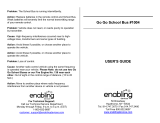
W
EBASTO
S
CHOLASTIC
S
ERIES
1INTRODUCTION
1-1
1. Introduction
1.1
Scope and Purpose
This
manual is intended to support authorized Webasto
trained distributors, dealers and personnel in the
installation of the Scholastic Series coolant heater.
Webasto heating and cooling systems require qualified
and/or professional installation and repair technicians.
Warranty shall be void if not installed by a certified or
trained installer/repair technician who has s
uccessfully
completed the factory training course for installation and
repair of Webasto heating and cooling systems, and has
been provided with the technical information, tools and
equipment required to properly complete the necessary
installation /repairs.
Improper installation or repair of Webasto heating and
cooling systems can cause fire or the leakage of deadly
carbon monoxide leading to serious injury or
death.
Any use, operation, installation, modification or
application of the product not described in Webasto
manuals, or subjecting the product to extreme or unusual
conditions beyond the limits of specified performance
characteristics is misuse of the product.
Failure to comply with all installation instructions is a
misuse of Webasto product. The same applies for
repairs without using genuine Webasto service parts.
This will void the coolant heaters “Official Marks of
Conformity.”
ALWAYS carefully follow Webasto installation and repair
instructions and heed all WARNINGS.
1.2
Meaning of Warnings, Cautions,
and Notes
Warnings, Cautions and Notes in this manual have the
following meaning:
1.3 Additional Documentation to be
Used
This manual contains all of the information and
procedures necessary for
the installation of the
Scholastic Series heater.
The use of additional documentation is normally not
necessary. Vehicle specific installation guides (when
available) may be used as complementary information if
necessary.
1.4 General Safety Regulations and
Information
The general safety regulations for the prevention of
accidents and relevant operating safety instructions must
be observed at all times.
The specific safety regulations applicable to this manual
are highlighted in the individual chapters by Warnings,
Cautions and Notes.
1.4.1 General Safety Notes
The heater may only be installed in vehicles, with a
minimum coolant capacity of 10 litres (2.6 US Gal.).
The heater must not be installed in the passenger
compartments of the vehicle. Should the heater be
installed in such a compartment, the installation box must
be sealed tight against the vehicle interior. There must
be sufficient ventilation of the installation box from the
exterior in order not to exceed a maximum temperature
of 60 °C (140 °F) in the installation box. Excessive
temperatures may cause malfunctions.
NOTE:
This heading is used to highlight and draw specific
attention to information.
CAUTION
This heading is used to highlight that
non-compliance with instructions or procedures may
cause damage to equipment.
WARNING
This heading is used to highlight that
non-compliance with instructions or procedures may
cause injuries or lethal accidents to personnel.
WARNING
Due
to
the
danger
of
poisoning
and
suffocation,
the
heater
must
not
be
operated
in
enclosed
areas,
such
as
garages
or
workshops,
without
an
exhaust
venting
system,
not
even
if
the
start-up
is
activated
by
the
timer
or
remote
start
device.
Where
flammable
fumes
or
dust
may
build
up
(e.g.
in
the
vicinity
of
fuel,
coal,
wood,
cereal
grain
deposits
or
similar
situations)
the
heater
must
be
switched
off
to
prevent
explosions.
DANGER: Heater must be switched "off" when
refueling at filling stations and/or while loading or
unloading flammable materials for transport, to
prevent the risk of explosion. Please review
owner's manual for safety and use instructions.

























